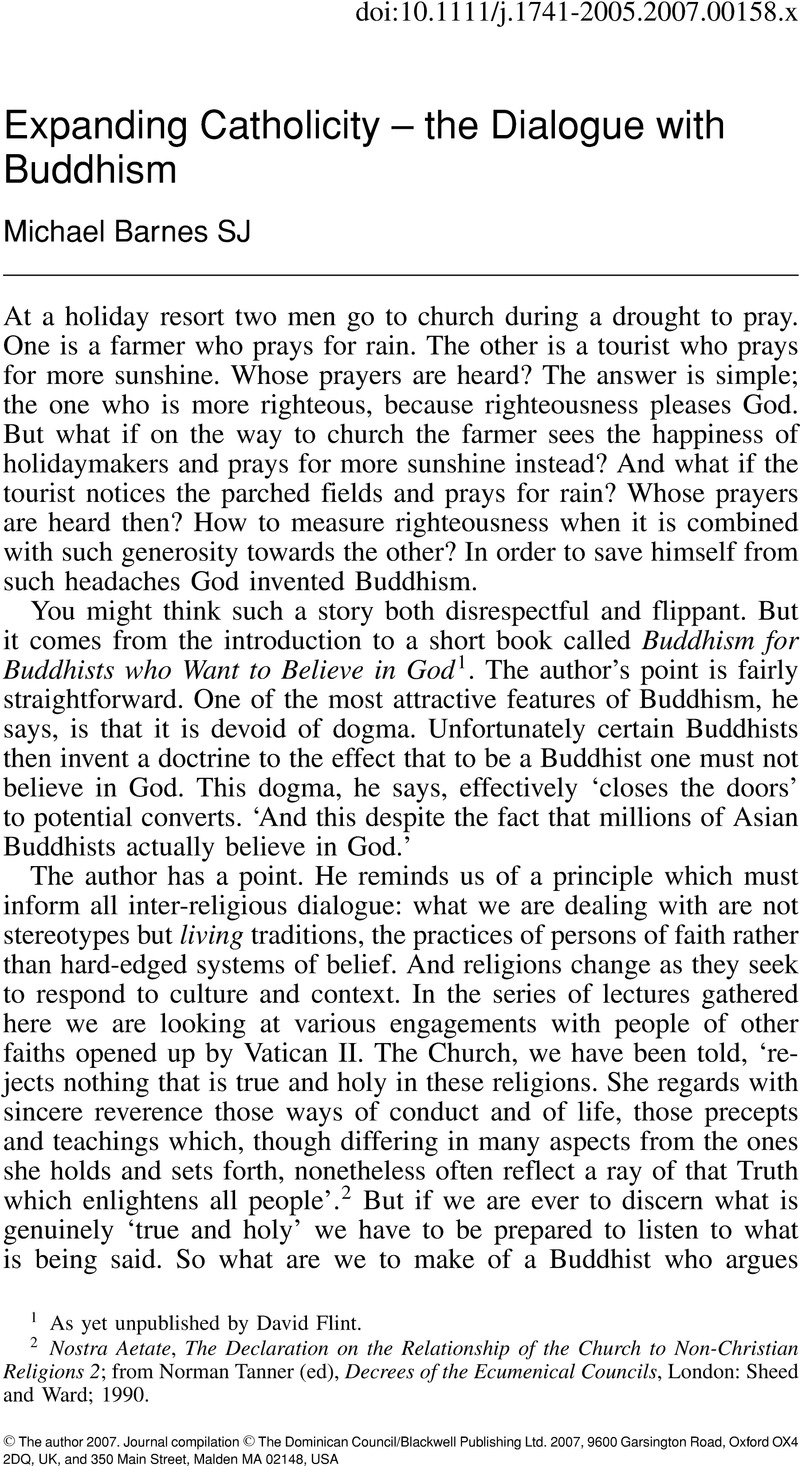No CrossRef data available.
Published online by Cambridge University Press: 01 January 2024

1 As yet unpublished by David Flint.
2 Nostra Aetate, The Declaration on the Relationship of the Church to Non-Christian Religions 2; from Tanner, Norman (ed), Decrees of the Ecumenical Councils, London: Sheed and Ward; 1990Google Scholar.
3 For a straightforward account of sassatavada and ucchedavada in the Theravada tradition see Walpola Rahula's celebrated study, What the Buddha Taught, Bedford: Gordon Fraser; 1967Google Scholar; and for a fascinating commentary from a Christian theologian see D'Silva, Lynn, The Problem of the Self in Buddhism and Christianity, London: Macmillan; 1979CrossRefGoogle Scholar
4 From rTsa she tik chen rigs pa'i rgya mysho, Sarnath: 1973; p 431Google Scholar. Quoted by Stephen Batchelor in ‘The Other Enlightenment Project’, from King, Ursula (ed), Faith and Praxis in a Post-Modern Age, London:Cassells; 1998Google Scholar.
5 The most detailed account of the formation of the document is by John Oesterreicher in Herbert Vorgrimler (ed), Commentary on the Documents of Vatican II, Volume III, pp 1-154. For a more recent account see Alberigo, Giuseppe (ed), History of Vatican II, Maryknoll: Orbis; 1995-Google Scholar.
6 Paul, Pope John II, Crossing the Threshold of Hope, London: Cape; 1994Google Scholar.
7 Quoted in Pro Dialogo (bulletin of Pontifical Council for Interreligious Dialogue) 102, 1999, p 343.
8 See especially Hugo Enomiya Lassalle, Zen Meditation for Christians, Open Court; 1974.
9 Dumoulin, H., A History of Zen Buddhism, London: Faber; 1963Google Scholar.
10 Kadowaki, J.K., Zen and the Bible, Maryknoll: Orbis; 2002Google Scholar. Johnston, William, The Still Point, San Francisco: Harper and Row; 1970Google Scholar; Silent Music, London: Fontana; 1976Google Scholar; Christian Zen, Dublin: Gill and Macmillan; 1979Google Scholar.
11 See Jager, EG Willigis, Contemplation: a Christian Path, Liguori publications, 1994Google Scholar
12 See especially Zen Spirit, Christian Spirit: the Place of Zen in Christian Life, Continuum, 1996Google Scholar; and Zen Gifts to Christians, London: Continuum; 2000Google Scholar.
13 See McInnes, Elaine, Zen Contemplation for Christians:a Bridge of Living Water, Sheed and Ward, 2003Google Scholar.
14 See EG Christian Zen, pp 57ff.
15 Available at http://www.archbishopofcanterbury.org.
16 See Panikkar, Raimon, The Silence of God: the Answer of the Buddha, Orbis: 1989Google Scholar; especially pp 148ff.
To send this article to your Kindle, first ensure no-reply@cambridge.org is added to your Approved Personal Document E-mail List under your Personal Document Settings on the Manage Your Content and Devices page of your Amazon account. Then enter the ‘name’ part of your Kindle email address below. Find out more about sending to your Kindle. Find out more about saving to your Kindle.
Note you can select to save to either the @free.kindle.com or @kindle.com variations. ‘@free.kindle.com’ emails are free but can only be saved to your device when it is connected to wi-fi. ‘@kindle.com’ emails can be delivered even when you are not connected to wi-fi, but note that service fees apply.
Find out more about the Kindle Personal Document Service.
To save this article to your Dropbox account, please select one or more formats and confirm that you agree to abide by our usage policies. If this is the first time you used this feature, you will be asked to authorise Cambridge Core to connect with your Dropbox account. Find out more about saving content to Dropbox.
To save this article to your Google Drive account, please select one or more formats and confirm that you agree to abide by our usage policies. If this is the first time you used this feature, you will be asked to authorise Cambridge Core to connect with your Google Drive account. Find out more about saving content to Google Drive.